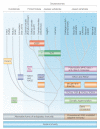Reconstructing immune phylogeny: new perspectives
- PMID: 16261174
- PMCID: PMC3683834
- DOI: 10.1038/nri1712
Reconstructing immune phylogeny: new perspectives
Abstract
Numerous studies of the mammalian immune system have begun to uncover profound interrelationships, as well as fundamental differences, between the adaptive and innate systems of immune recognition. Coincident with these investigations, the increasing experimental accessibility of non-mammalian jawed vertebrates, jawless vertebrates, protochordates and invertebrates has provided intriguing new information regarding the likely patterns of emergence of immune-related molecules during metazoan phylogeny, as well as the evolution of alternative mechanisms for receptor diversification. Such findings blur traditional distinctions between adaptive and innate immunity and emphasize that, throughout evolution, the immune system has used a remarkably extensive variety of solutions to meet fundamentally similar requirements for host protection.
Figures



References
-
- Agrawal A, Eastman QM, Schatz DG. Transposition mediated by RAG1 and RAG2 and its implications for the evolution of the immune system. Nature. 1998;394:744–751. - PubMed
-
- Hiom K, Melek M, Gellert M. DNA transposition by the RAG1 and RAG2 proteins: a possible source of oncogenic translocations. Cell. 1998;94:463–470. - PubMed
-
- Cannon JP, Haire RN, Rast JP, Litman GW. The phylogenetic origins of the antigen binding receptors and somatic diversification mechanisms. Immunol. Rev. 2004;200:12–22. - PubMed
-
-
Chatterji M, Tsai CL, Schatz DG. New concepts in the regulation of an ancient reaction: transposition by RAG1/RAG2. Immunol. Rev. 2004;200:261–271. A comprehensive review of RAG-mediated transposition and its role in the origin of adaptive immunity.
-
-
- Litman GW, Cannon JP, Rast JP. New insights into mechanisms of immune receptor diversification. Adv. Immunol. 2005;87:209–236. - PubMed
Publication types
MeSH terms
Substances
Grants and funding
LinkOut - more resources
Full Text Sources
Other Literature Sources

